The restored forest

Brackenhurst Conference Centre and Botanic Gardens in Tigoni, 25-km northwest of Nairobi through the Limuru highlands of lush green tea fields. Rupi Mangat visits a forest that’s been uprooted and replaced with all-indigenous trees, boosting the local animal life. PHOTO| RUPI MANGAT
What you need to know:
- It’s a beautiful October morning at the Brackenhurst Conference Centre and Botanic Gardens in Tigoni, 25 kilometres northwest of Nairobi through the Limuru highlands of lush green tea fields.
- Nicholson – a vet – and his team started the landscape restoration programme on the 100-acre land, gradually replacing the non-indigenous and invasive plants with local indigenous trees.
- Likewise, the colobus monkeys have returned after 15 years because of the podo. This black and white monkey of the old forest is arboreal, meaning it rarely comes down to earth, and is a specialised leaf eater.
It’s popping with colour under the gorgeous blue sky. Orange aloes in bloom attract an array of colourful sunbirds – Variable, Tacazze,
Golden-winged and more. An African goshawk vanishes into the canopy of a tree. Many more feathered friends keep us birders glued skyward.
It’s a beautiful October morning at the Brackenhurst Conference Centre and Botanic Gardens in Tigoni, 25 kilometres northwest of Nairobi through the Limuru highlands of lush green tea fields. The birds lead the way through the garden. A pair of eagles soar the skies by the entrance to a grove of trees.
Under the canopy, it’s cool and under our feet, dry leaves crinkle on the forest floor.
The Brackenhurst forest is an amazing landscape restoration project that’s replaced the cypress, eucalyptus and wattle trees that were introduced here only 17 years ago to provide wood fuel for the tea plantations.

The unbroken forest canopy of indigenous trees planted 17 years ago at Brackenhurst Conference Centre and Botanic Gardens, Tigoni. PHOTO| RUPI MANGAT
Most people see a forest as a place just for trees, but there’s more to it than just that. Walking through with the rest of the birders enraptured with the forest birds, it’s exciting listening to Mark Nicholson, director of Plants for Life at the Brackenhurst Botanic Garden.
Seventeen years ago he walked into Brackenhurst to complain about all the non-indigenous trees and invasive plants that were draining the water out of the earth and making the soils poorer, besides driving off all the wild and wonderful creatures. The good folks at Brackenhurst listened to him and then asked him ‘Well, if you are so concerned why don’t you do something about it?’
That was his ‘eureka’ moment.
Nicholson – a vet – and his team started the landscape restoration programme on the 100-acre land, gradually replacing the non-indigenous and invasive plants with local indigenous trees.
Strolling through the cool of the forest with rays of sunlight streaming through to the leaf-clad ground, we’re looking at hardwoods like Prunus africana, Podocarpus and Warburgia ugandensis among the 50 species in the forest.

Colourful indigenous flowering plants that attract birds and bees at Brackenhurst Conference Centre and Botanic Gardens. PHOTO| RUPI MANGAT
All three of these trees – that until 100 years ago were common – are listed as vulnerable on the IUCN Red list of globally threatened species. Every one of these trees has medicinal properties, offers ecological services and is an important food source for wildlife. The legendary Dian Fossey documented that the fruits of Prunus africana found on one of the mountains of the Volcanoes National Park in Rwanda were highly favoured by mountain gorillas.
Likewise, the colobus monkeys have returned after 15 years because of the podo. This black and white monkey of the old forest is arboreal, meaning it rarely comes down to earth, and is a specialised leaf eater.

Restored indigenous forest at Brackenhurst Conference Centre and Botanic Gardens in Tigoni. PHOTO| RUPI MANGAT
Nicholson continues with the list of returnees to the ‘new’ indigenous forest – genets, bushpigs, civets.
“Forests are more than just trees,” says Nicholson, stopping by a swamp edged by sedges.
“They are big in biodiversity and trophic levels (in simple language it’s the food chain) and so we’re seeing more birds, mammals, insects and reptiles.”
With the midday sun above us we step out of the forest and stroll past some of Africa’s rarest trees that are close to extinction in the wild like Kenya’s Gigasiphon macrosiphon with a handful found in Kaya Muhaka on South Coast, and the Malawian national tree, Mulanje cedar (Widdringtonia whytei) that will be gone in 10 years if their habitats are not protected.
The walk’s built up an appetite and we relish lunch – steaks, cakes and coffee at the Muna Tree Café, named after a trio of the indigenous trees in the garden. In the high-ceilinged, close to a century-old dining room, a gargantuan buffet is served under the gaze of Lord and Lady Brackenhurst.
Be at Brackenhurst https://brackenhurst.com/
- It’s great for families and nature-lovers. There’s lots to do like biking, hiking and team building.
- Join Nature Kenya naturekenya.org for a great outdoor life as you learn about the wild and wonderful world around us.
www.rupitheafricantrotter.wordpress.com




